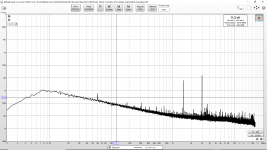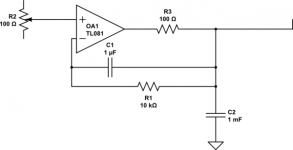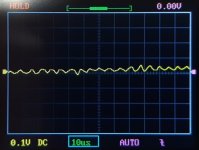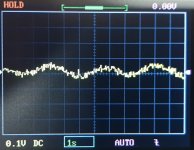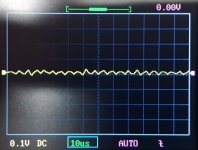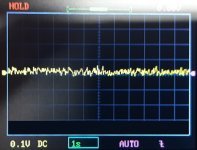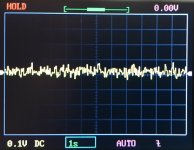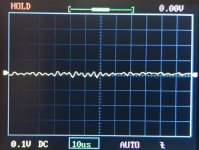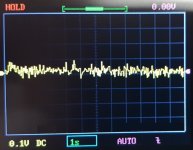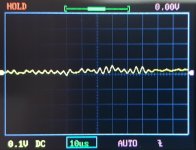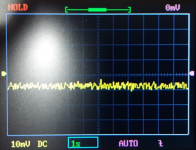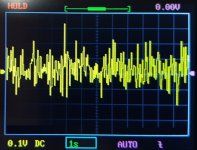Is that spur at 2kHz a harmonic of the 1kHz? like what if you change the 1kHz frequency, does the 2kHz spur follow it?
It is a harmonic. See the attached with 1.5kHz full scale and the resulting 3kHz harmonic.
EDIT: I don't think anyone ever measured like you want to do. How will you correlate measured changes with how you judge the dac to sound? Otherwise, how do you know anything you do makes the dac sound better, worse, or has no effect?
Well first of all I have already said that I use a combination of:
- Measurements of DAC
- Measurements of sub-circuits and components such as the power supplies.
- Listening tests where I control as many factors as possible and ping-pong switch between DACs (on a short time scale, a few seconds to a few minutes) with everything else (environment, my ears, speakers, amplifiers, etc) held as constant as possible.
I don't have professional equipment at home but I think my little 60 dB LNA is not bad.
Can you make that measurement you want with your scope and post the result? If you post a picture of the connections (probe and ground) I will do my best to copy.
Attachments
At least now your noise measurements are on par with what 7805+AMS1117 should deliver.
Ok. Can anyone post a measurement (scope voltage waveform or a spectrum) of what is achieved on this board with a better/recommended regulator?
Until I buy better regulators I was wondering about doing an experiment with the pictured circuit that I found online (after a precision reference). Do you think this might be a good idea?
This is what the author said about it:
How do you think that might perform relative to the existing LM7805 & AMS1117?Your output noise density will be defined by THREE contributors
- Noise density of your voltage reference
- Noise density of your opamp internal KT noise and its VDD (power supply) deterministic and random noise,
- The 100 ohm resistor from opamp output to the 1,000uF capacitor, at about 1.3 nanoVolt/rtHz. The output bandwidth will be [100 ohm, 1mF = 0.1 second or 1.6Hz] scaled up by PI/2 from the Integration DC to infinity of ArcTangent, or 2.6Hz bandwidth. The total integrated noise due to Rout (opamp output pin, to 1,000uF) will be 1.3nV * sqrt(1.5) =1.5 nanoVolts RMS
I have a couple LM4562. How about filtering with the LM4562?
Attachments
Can you make that measurement you want with your scope and post the result?
Sorry, the ES9038Q2M dac is not currently operational. Only one running these days is AK4499.
Good PDF on probe techniques at: https://download.tek.com/document/02_ABCs-of-Probes-Primer.pdf
Best to use a little spring ground at high frequencies. If not possible, ground lead should be connected near the probe as possible. You can try connecting the ground in different locations to see how much that affects the measurement.
EDIT: Tips on grounding in pages 46-49 of the PDF.
Last edited:
Sorry, the ES9038Q2M dac is not currently operational. Only one running these days is AK4499.
Good PDF on probe techniques at: https://download.tek.com/document/02...bes-Primer.pdf
Best to use a little spring ground at high frequencies. If not possible, ground lead should be connected near the probe as possible. You can try connecting the ground in different locations to see how much that affects the measurement.
EDIT: Tips on grounding in pages 46-49 of the PDF.
What time base do you want to see? Just AVCC-R?
I might try cutting a piece of the smallest diameter coax I have and soldering it directly. In the past I have used micro semi-rigid to SMA soldered directly.
I fear the scope will be far too noisy compared with the LNA. Perhaps I should try: AVCC-R >> Coax >> LNA >> Scope ?
I would be interested in see all the rails you want to measure. The timebase should be adjusted to whatever settings show information of possible interest. RF frequency spikes might cause some problems, so might some lower frequency junk. This would just be to see what you can find to start with.
If the LNA can work up to some frequency above audio you could try to AC couple it and use it as a preamp for the scope. Most scopes have at least a 2mV per division scale, but with 10:1 probes it will be 20mV. Sometimes I will use a probe I can set to 1:1 even though its no longer frequency compensated that way. You may still see something that gets your attention. Have to try it and see. I also switch try switching the scope trigger to 'normal' mode, then adjust the trigger level from too high down to where it just starts to trigger. That can help make it easier to find the biggest spikes. If there is a repetitive waveform buried in a lot of noise, sometimes setting the acquisition mode of a digital scope to 'average' and playing with the trigger settings can help to visualize the buried signal better. My advice would be to always learn how to use all the features of any scope you may have.
If the LNA can work up to some frequency above audio you could try to AC couple it and use it as a preamp for the scope. Most scopes have at least a 2mV per division scale, but with 10:1 probes it will be 20mV. Sometimes I will use a probe I can set to 1:1 even though its no longer frequency compensated that way. You may still see something that gets your attention. Have to try it and see. I also switch try switching the scope trigger to 'normal' mode, then adjust the trigger level from too high down to where it just starts to trigger. That can help make it easier to find the biggest spikes. If there is a repetitive waveform buried in a lot of noise, sometimes setting the acquisition mode of a digital scope to 'average' and playing with the trigger settings can help to visualize the buried signal better. My advice would be to always learn how to use all the features of any scope you may have.
Last edited:
I have to use the LNA due to noise. So with 60 dB gain the scale per division is 10uV (when the photo shows 10mV) and 100uV (when the photo shows 100mV).
Starting with input to AMS1117-3.3:
Starting with input to AMS1117-3.3:
- DAC Powered Down (10uV/Division due to 60 dB LNA) 100ms
- DAC Powered Down (10uV/Division due to 60 dB LNA) 10us
- DAC Idle (100 uV/Division due to 60 dB LNA) 1s
- DAC Idle (100 uV/Division due to 60 dB LNA) 10us
- DAC 1kHz Fullscale (100uV/Division due to 60 dB LNA) 1s
- DAC 1kHz Fullscale (100uV/Division due to 60 dB LNA) 10us
Attachments
-
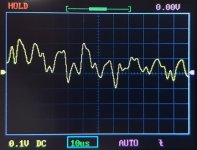 Compressed 100uV per Div Input of AMS1117 1kHz Full Scale 10us.jpg70.3 KB · Views: 50
Compressed 100uV per Div Input of AMS1117 1kHz Full Scale 10us.jpg70.3 KB · Views: 50 -
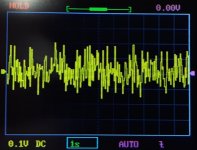 Compressed 100uV per Div Input of AMS1117 1kHz Full Scale 1s.jpg67.2 KB · Views: 59
Compressed 100uV per Div Input of AMS1117 1kHz Full Scale 1s.jpg67.2 KB · Views: 59 -
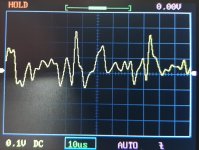 Compressed 100uV per Div Input of AMS1117 Idle 10us.jpg131.8 KB · Views: 51
Compressed 100uV per Div Input of AMS1117 Idle 10us.jpg131.8 KB · Views: 51 -
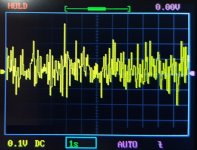 Compressed 100uV per Div Input of AMS1117 Idle 1s.jpg100 KB · Views: 146
Compressed 100uV per Div Input of AMS1117 Idle 1s.jpg100 KB · Views: 146 -
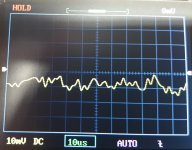 Compressed 10uV per Div Input of AMS1117 OFF 10us.jpg132.4 KB · Views: 144
Compressed 10uV per Div Input of AMS1117 OFF 10us.jpg132.4 KB · Views: 144 -
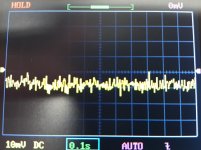 Compressed 10uV per Div Input of AMS1117 OFF 100ms.jpg147 KB · Views: 149
Compressed 10uV per Div Input of AMS1117 OFF 100ms.jpg147 KB · Views: 149
Last edited:
Sean Olive. JBL uses test panels of human listeners to evaluate speakers.
Sean Olive's The Dishonesty of Sighted Listening Tests.Now I use a combination of single-blind and sighted tests because it works fine, given the listeners I use.
kwowledge by listener of what device is used when doing listening test does not automatically imply a bias. if you are «emotionally compromised», to quote Spock, it can affect the result if you have expectations. But if you are serious/honest about audio, it would be shameful to assume nobody can make an accurate unblinded test. human CAN control themselves, and it is quite fortunate for the future of the human specie in general, i would say!
I assume everybody here is intelligent to make up their own mind when listening to audio and reading about other's sound evaluation/preference...and that why objective measurement are also needed.
«Not everything that can be counted counts and not everything that counts can be counted»
Maybe it would be better to put a disclaimer at the beginning of the thread so that we can keep on topic...?
I assume everybody here is intelligent to make up their own mind when listening to audio and reading about other's sound evaluation/preference...and that why objective measurement are also needed.
«Not everything that can be counted counts and not everything that counts can be counted»
Maybe it would be better to put a disclaimer at the beginning of the thread so that we can keep on topic...?
Again I have to use the LNA due to noise. So with 60 dB gain the scale per division is 100uV (when the photo shows 100mV).
Now AVCC_R:
Now AVCC_R:
- DAC Idle (100 uV/Div) 1s
- DAC Idle (100 uV/Div) 10us
- DAC 1kHz Fullscale (100uV/Div) 1s (Aliasing?)
- DAC 1kHz Fullscale (100uV/Div) 10us
Attachments
Again I have to use the LNA due to noise. So with 60 dB gain the scale per division is 100uV (when the photo shows 100mV).
Now VCCA:
Now VCCA:
- DAC Idle (100 uV/Div) 1s
- DAC Idle (100 uV/Div) 10us
- DAC 1kHz Fullscale (100uV/Div) 1s (Aliasing?)
- DAC 1kHz Fullscale (100uV/Div) 10us
Attachments
But if you are serious/honest about audio, it would be shameful to assume nobody can make an accurate unblinded test.
I am sorry, but this is a long time debunked assumptions by tons of experimental data in the last, say, 50 years of psychoacoustic research. Bottom line, assuming biases can be avoided is wrong, this is how the human brain works, period.
Again I have to use the LNA due to noise. So with 60 dB gain the scale per division is 100uV (when the photo shows 100mV).
Do yourself a favor and measure the setup noise as above, same conditions, by shorting the cable you are using to measure the PS noise. I am afraid you are measuring some ground loop collected crap (either by conduction or induction). Leave everything else unchanged, even keep the cable in the same position as for measuring the PS (only short it's ends). Such measurements are more difficult to do with a high degree of confidence than it appears at the first glance.
I am sorry, but this is a long time debunked assumptions by tons of experimental data in the last, say, 50 years of psychoacoustic research. Bottom line, assuming biases can be avoided is wrong, this is how the human brain works, period.
Don't be sorry. If this method works for you, fine.
Please keep posts on topic.
syn08; said:Do yourself a favor and measure the setup noise as above, same conditions, by shorting the cable you are using to measure the PS noise. I am afraid you are measuring some ground loop collected crap (either by conduction or induction). Leave everything else unchanged, even keep the cable in the same position as for measuring the PS (only short it's ends). Such measurements are more difficult to do with a high degree of confidence than it appears at the first glance.
The first attached image is at 10uV per division with the cable shorted (60 dB gain). The second attached image is the input to the AMS1117-3.3 (output of the LM7805 monolithic noise generator) at 100uV per division (cable not shorted).
The scope is far more noisy than the sound card + LNA. It can be used to look for something above the frequency range of the sound card but if nothing else is revealed then I would stick with the much quieter sound card + LNA. Unless someone has a much better scope, which I do not.
I think for comparing different regulators the 60 dB LNA + 24 bit sound card ADC is fine.
It was suggested that I check for something else with a scope so I did. Since I don't see anything else I will stick with the earlier and much higher quality sound card data.
Attachments
Last edited:
Not saying it would be applicable to my board. However I would love to see measurements on a very good or great ES9038Q2M example. Certain noise and spurs will come from the ES9038Q2M and it would be helpful if I knew what was "normal" in a very good or great ES9038Q2M example.
Fair enough. Yes, it seems that has not been a popular approach in this thread ... it seems many excuses to are explored to avoid it.
Unfortunately I dont have anything of use to you. havent played with any of these boards and i'm more focused on multichannel (digital crossover). well, I WAS ... until someone wiped out all of the ESS stock, worldwide ...
here you go Review and Measurements of E1DA 9038S BAL Portable DAC & Amp | Audio Science Review (ASR) Forum
Please keep posts on topic.
You too, please. Thank you.
Last edited:
The first attached image is at 10uV per division with the cable shorted (60 dB gain). The second attached image is the input to the AMS1117-3.3 (output of the LM7805 monolithic noise generator) at 100uV per division (cable not shorted).
The scope is far more noisy than the sound card + LNA. It can be used to look for something above the frequency range of the sound card but if nothing else is revealed then I would stick with the much quieter sound card + LNA. Unless someone has a much better scope, which I do not.
I think for comparing different regulators the 60 dB LNA + 24 bit sound card ADC is fine.
It was suggested that I check for something else with a scope so I did. Since I don't see anything else I will stick with the earlier and much higher quality sound card data.
You keep doing your thing, please slow down and look carefully at what you are doing.
There's nothing to compare the cable short results, other than maybe with your previous result with the DAC "idle" or powered down? Please check the input short result, as follows: your cable has two ends at the DAC board: ground and "hot". The ground end goes to the DAC board ground; keep it there, then connect the "hot" end to the same ground. Do not touch anything between measurements. Now, measure with the DAC powered down, "idle", then with the DAC board @1KHz full scale. Post the results.
Last edited:
Probably someone had to redesign an AKM based product ASAP and start production instantly due to the fire...
Yes. that's what I assume. Hard to believe they have so little stock that a single manufacturer could buy everything from every distributor. With any luck there is more stock on the way and it wont be 4 months like Mouser says.
definitely recommend looking at that thread I linked. its a very good result from a well executed, but minimal design and he got those results on USB power!!! great measurements as well from Amirm and plenty of discussion with the designer in the thread.
IMO this is an ongoing mark up speculation attempt, after AKM posted an update about the fire incident, a few days ago.
Situation regarding semiconductor plant fire and product supply | News | ABOUT AKM | Asahi Kasei Microdevices (AKM)
Not a chance in hell they'll resume production until 2022. Otherwise said, AKM successfully screwed everybody.
Situation regarding semiconductor plant fire and product supply | News | ABOUT AKM | Asahi Kasei Microdevices (AKM)
Not a chance in hell they'll resume production until 2022. Otherwise said, AKM successfully screwed everybody.
- Home
- Source & Line
- Digital Line Level
- ES9038Q2M Board
